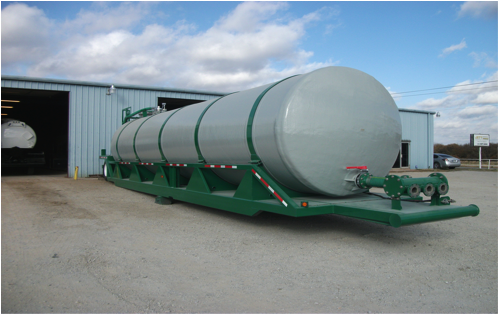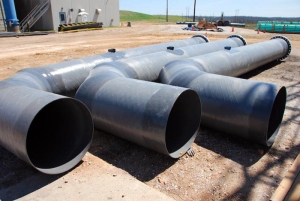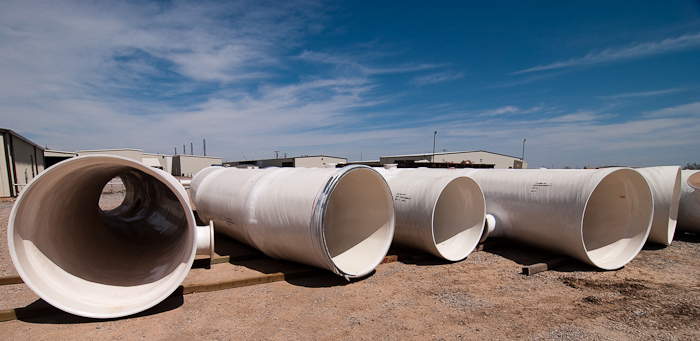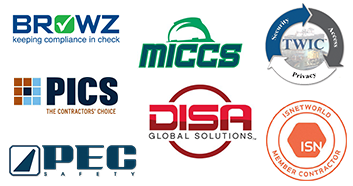General Fiberglass Reinforced Polymer Composition
In this excerpt from our newest eBook Chemical Processing eBook: FRP Applications, Opportunities, and Solutions we share some basic information on the composition of Fiberglass Reinforced Polymers (FRP).
There are four main ingredients that FRP are comprised of: resins, reinforcements, fillers, and additives/modifiers. Each ingredient is equally important and all ingredients play an important role in determining the properties of the finished FRP products. To simplify, think of the resin (polymer) as the glue or the binding agent. The mechanical strength is provided by the reinforcements.
Resins
The primary functions of the resin are to transfer stress between the reinforcing fibers, act as a glue to hold the fibers together, and protect the fibers from mechanical and environmental damage. Resins are divided into two major groups known as thermoset and thermoplastic. Thermoplastic resins become soft when heated, and may be shaped or molded while in a heated semi-fluid state and become rigid when cooled. Thermoset resins, on the other hand, are usually liquids or low melting point solids in their initial form.
Reinforcements: Fibers and Forms
Generally speaking there are four common types of fibers broadly used in the FRP industry: glass, carbon, natural, and arimid. Each has their advantages and applications. Similarly, reinforcements are available in forms to serve a wide range of processes, service and end product requirements. 10
Common materials used as reinforcement include woven roving, milled fiber, chopped strands, continuous chopped, and thermo-formable mat. Reinforcement materials can be designed with unique fiber architectures and be preformed (shaped) depending on the product requirements and manufacturing process.
Fillers
Fillers are used as process or performance aids to impart special properties to the end product. Some examples of inorganic fillers include calcium carbonate, hydrous aluminum silicate, alumina trihydrate, and calcium sulfate. In some circumstances fillers and additives can play a critical role in lowering the cost of compounds by diluting expensive resins and reducing the amount of reinforcements. Furthermore, fillers and additives improve compound rheology, fiber-loading uniformity, enhances mechanical and chemical performance, and reduces shrinkage.
Additives and Modifiers
Additives and modifiers perform critical functions despite their relative low quantity by weight when compared to the other ingredients such as resins, reinforcements and fillers. Some additives used in thermoset and thermoplastic composites include: low shrink/low profile (when smooth surfaces are required), fire resistance, air release, emission control, viscosity control, and electrical conductivity.
An important note is that FRP products can be custom made for their intended use. Understanding the intended function and services of the FRP, will aid the design and manufacturing processes to allow for an optimal finished product (i.e. corrosion resistance). Modifiers can include catalyst, promoters, inhibitors, colorants, release agents and thixotropic agents (i.e. fumed silica and certain clays).
Download our free ebook Chemical Processing eBook: FRP Applications, Opportunities, and Solutions to learn more about FRP.

 It seems like every time we look at Twitter or the news we see another story about a new way manufacturers are using FRP. The versatility of FRP is one of the many things that make it a great construction and manufacturing material. We may not make
It seems like every time we look at Twitter or the news we see another story about a new way manufacturers are using FRP. The versatility of FRP is one of the many things that make it a great construction and manufacturing material. We may not make  According to the Composites Growth Initiative of the American Composites Manufacturing Association (ACMA), the Coefficient of Thermal Expansion is the change in length (or volume) per unit length (or volume) produced by a one degree Celsius rise in temperature.
According to the Composites Growth Initiative of the American Composites Manufacturing Association (ACMA), the Coefficient of Thermal Expansion is the change in length (or volume) per unit length (or volume) produced by a one degree Celsius rise in temperature.
 There are many important predictors of service life in industrial chemical processes; for example, humidity, temperature, pressure, and stress. Similarly, chemical resistance is a key predictor of
There are many important predictors of service life in industrial chemical processes; for example, humidity, temperature, pressure, and stress. Similarly, chemical resistance is a key predictor of  If you’ve been paying attention to fiberglass trends you’d know that corrosion, a serious problem that pits and corrodes most metals and metal alloys, has created huge market opportunities for Fiber Reinforced Polymers (FRP) including pipe, duct, and tanks. Despite the many opportunities FRP manufactures have seized over the years, some major obstacles still persist, chief among them is education—or getting the word out.
If you’ve been paying attention to fiberglass trends you’d know that corrosion, a serious problem that pits and corrodes most metals and metal alloys, has created huge market opportunities for Fiber Reinforced Polymers (FRP) including pipe, duct, and tanks. Despite the many opportunities FRP manufactures have seized over the years, some major obstacles still persist, chief among them is education—or getting the word out.  Recently featured by
Recently featured by 



